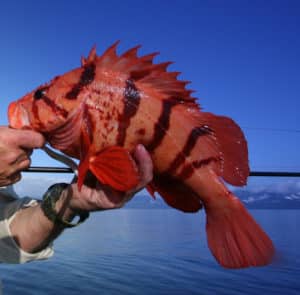Alien Creep-Out
QUESTION:
On a recent trip to Fiji, my diving friends found this creature in the water, alive but on its last legs (or fins). Despite some suspicions that it’s an alien from outer space, I think it’s some kind of deepwater skate or similar fish, based on its large eyes and strange shape. The front “feeler fins” are particularly bizarre; maybe they assist in locating food. Given the incredible depths very near shore in that area, I’m sure it’s a deepwater denizen, but I have had no luck in identifying it. What do you think?
Mark DeHaan
Rigby, Idaho
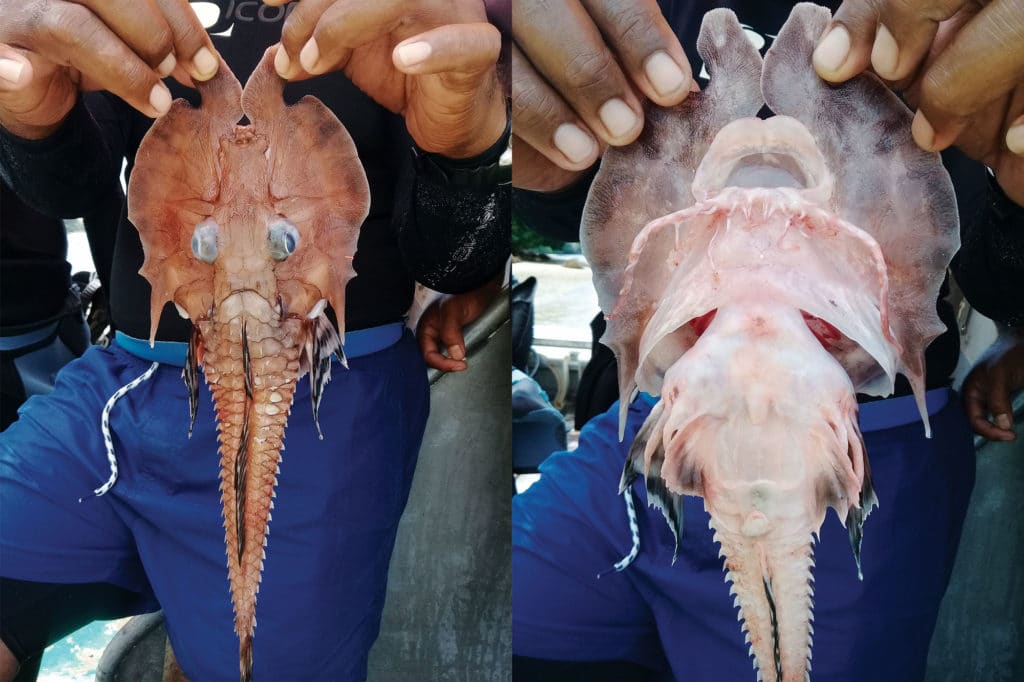
ANSWER:
That’s an interesting type of armored sea robin from the family Peristediidae. After conferring with expert Jeff Johnson from Australia’s Queensland Museum, we agree that it’s probably a very large -jaggedhead gurnard (Gargariscus –prionocephalus). It’s also known as a sawhead sea robin, so named because the sides of the head have a very jagged jigsawlike appearance when these fish are -juveniles. However, since this gurnard is known to grow to only around 12 inches long (about the size of your find), perhaps your specimen proves the sides of the head smooth out on really old adult fish. Either that, or you have found a new type of Gargariscus. Jaggedhead gurnards are, as you suspect, a deepwater species normally living on or near the bottom at depths of 600 to 1,200 feet on the edge of the continental shelf and slopes of Western Pacific islands. They range from Japan south to the Philippines and the Arafura Sea north of Australia, but do not—until now—seem to have been officially recorded from Fiji. From looking at videos of closely related armored sea robins, I would surmise the front feeler fins are probably covered in taste buds and, held in contact with the bottom, help in the search of food—so, again, good call. More -interesting are the elongated pectoral fin rays, which are used to “walk” over the bottom.
—-Ben Diggles
Pint-Size Croaker
QUESTION:
One night while jigging for bait in 33 feet of water off Fort Lauderdale, we caught this little guy. My buddy and I argued in the dark for a few minutes about if it was a croaker. I insisted the head shape, large eye, and mouth location are not that of a croaker. My buddy gave in and just said, man, you know way too much about croakers…. now get back to making bait! Please help me Fish Facts: You are my only hope.
Jason Arnold
Fort Lauderdale, Florida
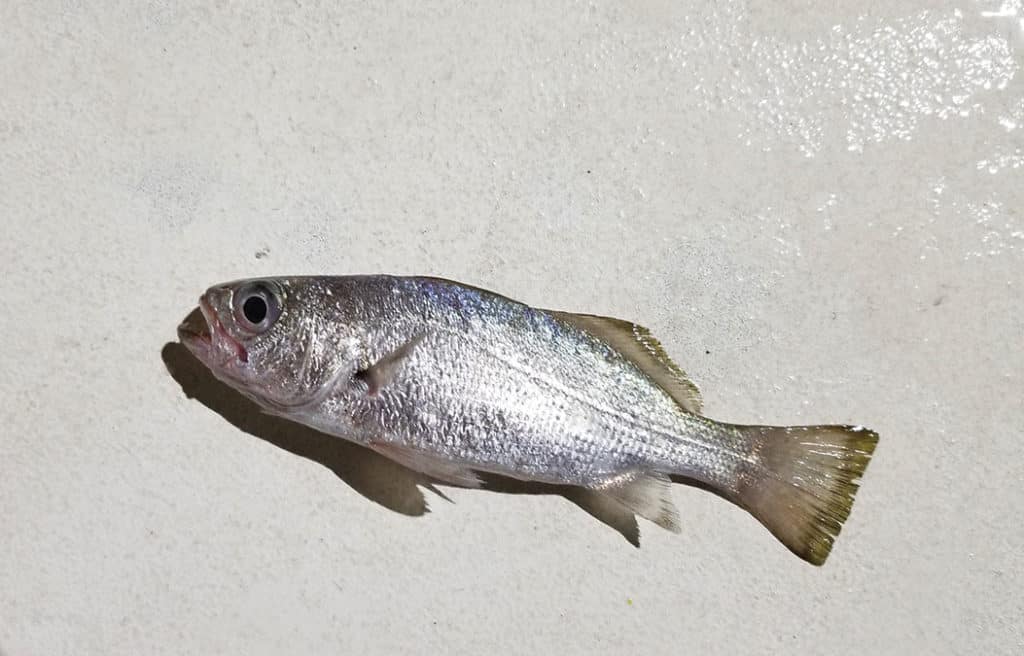
ANSWER:
Jason, I’m afraid your buddy wins this round! Although this fish is a bit different than many of the other members of the family Sciaenidae (the drums and croakers), it is a croaker, nonetheless. To be exact, it’s a reef croaker, Odontoscion dentex, a relatively small species usually well under a foot in length. The reef croaker ranges from Florida to Brazil, including the southern Gulf of Mexico and the Greater and Lesser Antilles in the western Atlantic Ocean. However, it appears to be absent from the Bahamas. It is most commonly encountered in areas with soft, sandy bottoms adjacent to coral reefs, at depths ranging from near the surface to around 100 feet. It feeds on small fishes and crustaceans such as shrimp, and is reputed to be good table fare.
— Ray Waldner
Redfish, Short and Stout
QUESTION:
What would cause the redfish on the left in this photo to be so much shorter and heavier at just 22 inches, weighing 7.04 pounds, than most redfish that are much longer? The other fish measured 23 inches but weighed just 4.5 pounds.
Capt. Steve Fennell
Ocean Tied Fishing Charters North Myrtle Beach, South Carolina
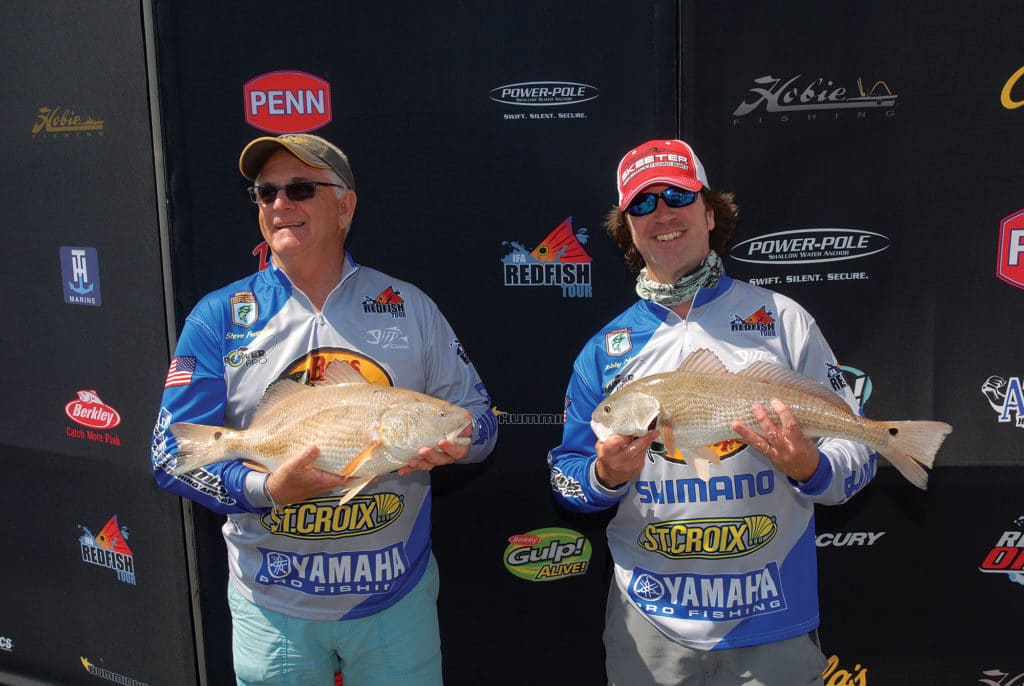
ANSWER:
One of the basic tenets of Charles Darwin’s theory of natural selection is that variation is present within every population or species, and the two red drum (Sciaenops ocellatus) in your photograph illustrate this. However, while Darwin was unknowingly alluding to genetic differences—which can affect some metabolic processes, hormone levels and the like—there are other factors, such as an organism’s activity level and the type and amount of food it consumes, that can also contribute to the type of variation that you observed. Without more information, it’s impossible to determine exactly what is responsible for one drum being so much stouter than is usual for the species, but differences of this sort and magnitude occur in many animals, including fishes.
—Ray Waldner
Dapper Little Snapper
QUESTION:
My sister caught this fish on some kind of electric reel off the coast of Alabama. I’m not sure how deep it was, but it was pretty far down there! I think she said it bit a piece of squid tentacle. Could it be some kind of brim?
Festus Murgy III
Montgomery, Alabama
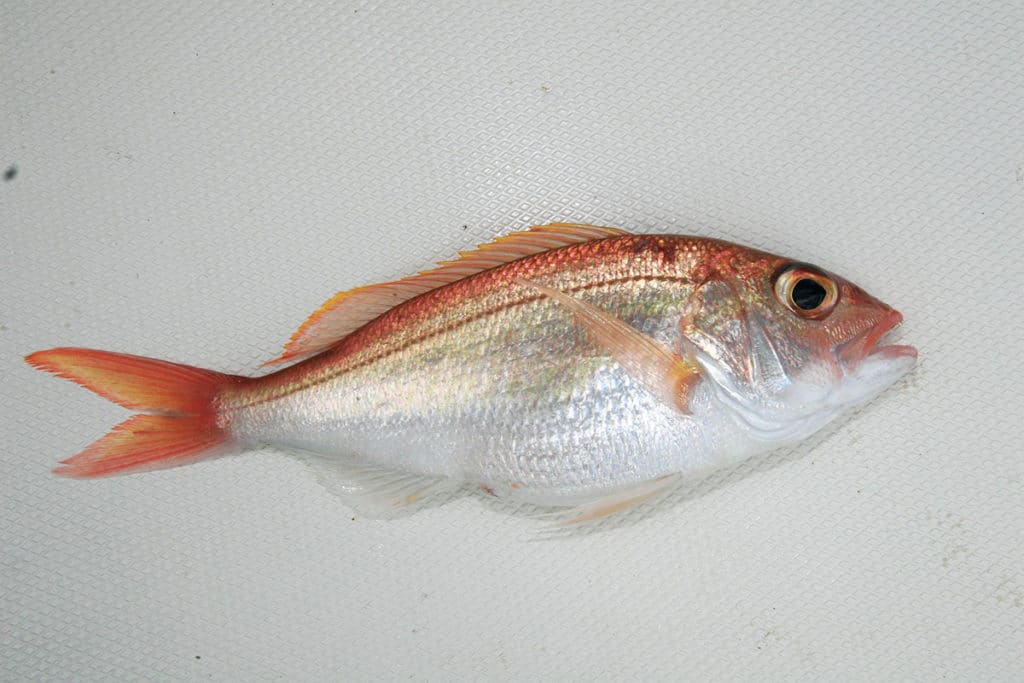
ANSWER:
Well, Festus, what you have there is a true snapper, albeit one of the smallest snapper species. This is a wenchman, Pristipomoides aquilonaris. When they’re caught, it’s usually accidentally by anglers fishing for live bait. I’ve heard claims that they can reach a foot and a half in length, but I’ve seen hundreds, and 10 inches has to be the -largest I’ve observed. Since they are a true snapper, I imagine they’re quite tasty, and in fact there has been some effort to manage them as part of a catch-all group of lesser-known -snappers. Wenchmen are found in the Western Atlantic from the Carolinas south to Brazil, and throughout the Gulf of Mexico. They prefer deeper water, occasionally as shallow 100 feet, but sometimes down to more than 1,300 feet. And as with most snappers, they prefer a rocky bottom.
Although a few, like yours, are caught on hook and line, most of what we know about the species comes from accidental catches from shrimp trawlers that skirt the edge of rough-bottom habitat.
—-Bob Shipp
Brilliant Bream
QUESTION:
I caught this brilliantly hued threadfin bream in about 100 feet of water near Shimizu, Japan. Can you confirm that species, and if so, whether it’s found outside Japan? I always seem to catch these in relatively deep, murky water—so why the bright colors?
Steve Wozniak
Alamo, California
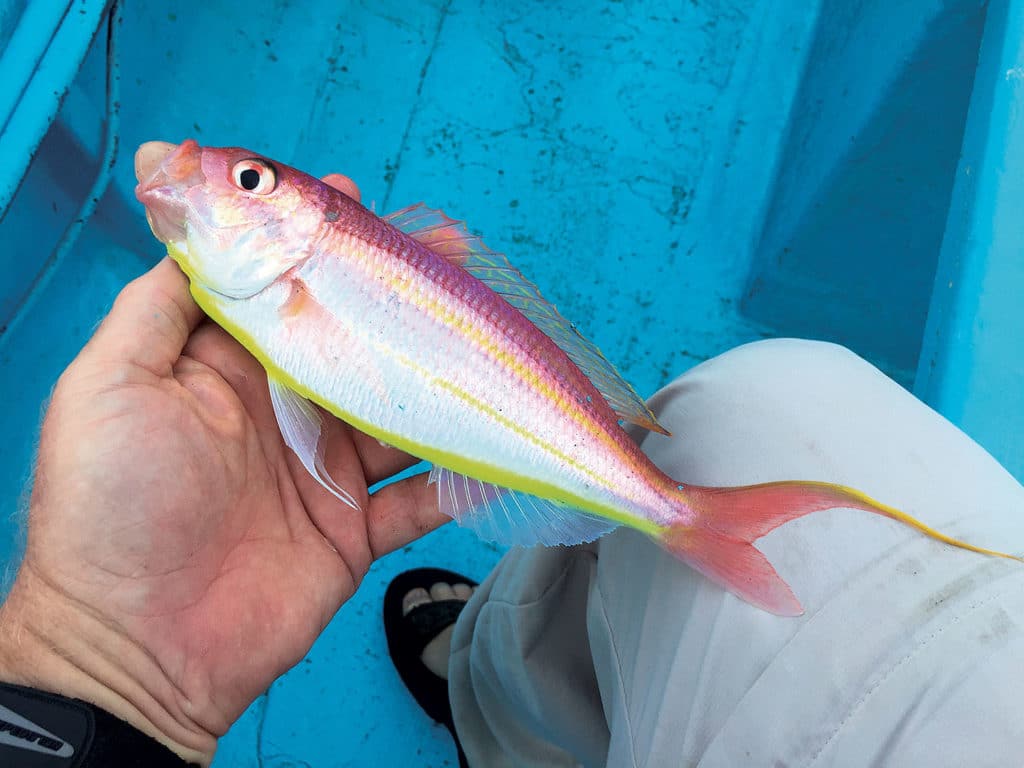
ANSWER:
That, Steve, is an aptly named yellowbelly threadfin bream (Nemipterus –bathybius). Threadfin bream (also known as whiptail bream), in the family Nemipteridae, are a diverse group of over 60 species of small, perchlike fishes found throughout the -tropical Indo-Pacific. Yellowbelly threadfin bream are commonly found over sandy or muddy bottoms at depths of 100 to 1,000 feet throughout the western Pacific, from Japan south to Indonesia and northwestern Australia. Juvenile N. bathybius up to 4 inches long feed on planktonic crustaceans (copepods, ostracods and amphipods), while adults grow to around 8 inches long and feed mainly on shrimp, crabs, smaller fish and squid. This species is what is called a rudimentary hermaphrodite, which means the males have functional testes but also a rudimentary ovary. For such a small species they’re relatively long-lived, with fish from southern Japan aged to a maximum of 8 years for males and 10 years for females. This bream’s reddish colors look bright at the surface in -daylight, but at depths below 100 feet, where red light wavelengths are attenuated, the color becomes far less visible and could even be a form of -camouflage.
—Ben Diggles
Sport Fishing’s Prestigious International Panel of Experts
Northeast: Mike Fahay, Sandy Hook Marine Lab, New Jersey
Southeast: Ray Waldner, Ph.D., Palm Beach Atlantic University, Florida
Gulf of Mexico: Bob Shipp, Ph.D., University of South Alabama
West Coast: Milton Love, Ph.D., UCSB, California
Far Pacific: Ben Diggles, Ph.D., Queensland, Australia
Bluewater Pelagics: John Graves, Ph.D., Virginia Institute of Marine Science
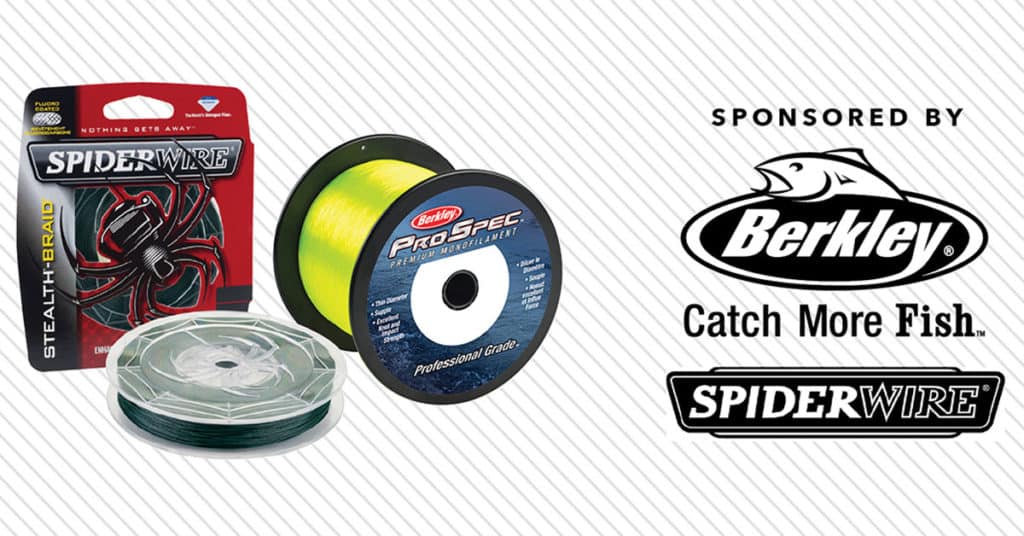
CHALLENGE OUR EXPERTS (And Win Up to 10,800 Yards of Line!)
Send in your question and any relevant photos of your mysterious catch or observation for our experts’ ID and feedback. If we publish your question and you have a shipping address within the United States or Canada, you’ll win a 3‑pound spool of Berkley Pro Spec ocean-blue or fluorescent-yellow monofilament (1,000 to 10,800 yards, depending on line strength) or a 1,500‑yard spool of Spiderwire Stealth braid up to 100‑pound‑test! Send questions and images via email to fishfacts@sportfishing.com (include your hometown) or via post to Sport Fishing Fish Facts, 460 N. Orlando Ave., Suite 200, Winter Park, FL 32789.

